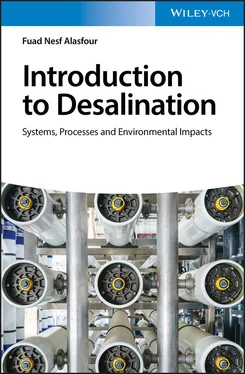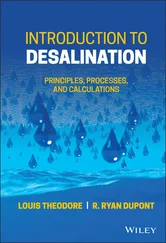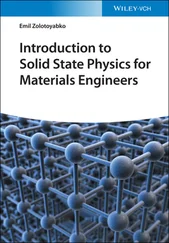1 Brine fluid (salty water): Which have very high value of salinity that can reach 90 000 ppm in case of thermal desalination system.
2 Concentrate: Which is a fluid with very high value of salinity in case of membrane desalination system.
3 Waste: Which is a product in the form of industrial concentrated fluids.
4 Thick liquor: Product that is produced under specific purposes and applications.
The products from desalination system can be in the following forms:
1 (a) Drinkable water with salinity less than 500 ppm.
2 (b) Fresh water.
3 (c) Fluid with specific required salinity or concentration.
Choosing the proper desalination system (technology) is always a challenge for engineers, because each desalination technology can provide different levels of performance under different circumstances (design and operational conditions). To ensure the performance level for any industrial desalination system, it must be examined in terms of 4E's – energy analysis, exergy analysis, economic analysis, and environmental analysis, in addition to sustainability tendency. Student should remember that selecting desalination system must fulfill the following criteria: low energy consumption, ability to use renewable energy, low cost of water production with high value of quality, and minimum negative environmental impacts, and it must be durable and reliable in operation with minimum required maintenance. Today reverse osmosis (RO) desalination systems present about 65% of worldwide installed capacity, while multi‐stage flashing (MSF) and multi‐effect evaporator (MEE) systems present about 21% and 7%, respectively.
As mentioned before, selecting desalination technology is a great challenge for engineers, and such selection process depends on the evaluation of the following four parameters:
1 Feed concentration: The first parameter that must be considered during desalination technology selection is feed salinity (concentration); the selected system must be able to handle the required salinity and to produce the required water or fluid quality. Figure 1.3shows the capability of different industrial desalination systems as per feed salinity and produced water purity.
2 Energy consumption: The second parameter that needs to be considered during selection is the value of specific energy consumption (SEC) that is required to desalt feedwater when electrical and/or thermal energies are used. Figure 1.4predicts the amount of SEC (kWh/m3) per desalination system.
3 Cost: The third parameter that must be considered during desalination selection is the cost of freshwater production ( Figure 1.5).
4 Emission: The fourth parameter is the level of emitted emissions of CO2 from desalination that affect the formation of greenhouse phenomenon ( Figure 1.6).

Figure 1.3Different desalination systems' capabilities based on feed salinity and produced water purity.
Source: Youssef et al. 2014 [3]. Reproduced with permission of Elsevier.

Figure 1.4Specific energy consumption using different desalination technologies.
Source: Youssef et al. 2014 [3]. Reproduced with permission of Elsevier.

Figure 1.5Cost of potable water production using different desalination technologies.
Source: Youssef et al. 2014 [3]. Reproduced with permission of Elsevier.

Figure 1.6CO 2released from different desalination technologies measured in kg/m 3.
Source: Youssef et al. 2014 [3]. Reproduced with permission of Elsevier.
1.4 Desalination Technologies
We will present and explain in this section the two most applied commercial types of desalination technologies: thermal and membrane systems.
1.4.1 Thermal Desalination System
There are several mature and reliable thermal desalination systems that are used today, and the two most conventional thermal (distillation) ones are:
1 MEE, where feed is heated, thus it evaporates via boiling process, then vapor is condensed after been screened through screen (demister) as potable water.
2 MSF, where feed is evaporated via flashing process due to sudden drop in pressure, then vapor is condensed after been screened through screen (demister) as potable water.
In addition to MEE and MSF, there are several types of thermal desalination systems that are used under specific conditions such as thermal vapor compression (TVC), mechanical vapor compression (MVC), and mechanical vapor recompression (MVR).
In general, thermal desalination systems are considered as an “old conventional” types, and they are characterized with simplicity in design and operation and even in maintenance. They have the ability to operate with feed salinity ranges from 20 000 to 100 000 ppm, the SEC varies from 4 to 6 kWh/m 3in addition to steam cost, and at the same time thermal desalination can produce high capacity of desalted water with high water purity (low TDS). As per processes, feedwater in thermal system desalination was subjected to their main progressive processes:
1 Heating: Where feed is heated via steam (thermal load) in first stage or by other type of energy source using its latent heat (hfg).
2 Evaporation: Feed is evaporated through feed phase change from liquid to vapor within the stages via boiling in case of MEE or via flashing in case of MSF.
3 Condensation: Freshwater vapor is condensed as potable water via heat exchanger (condenser).
The advantages and disadvantages of thermal system are presented.
Advantages of thermal distillation processes:
1 Suitable to treat high salinity feedwater such as seawaters.
2 Reliable and rigid system.
3 Require minimal conventional pretreatment for feedwater.
4 Capacity to use low waste thermal heat (low grade) from power plants to save energy.
5 Economical system if a heat source is available.
6 Easy in maintenance.
Disadvantages of thermal distillation:
1 The amount of water production depends on feed thermo‐physical properties (Tf, xf, …).
2 Tube scaling (CaSO4).
3 High value of SEC specially at elevated values of thermal performance.
Example 1.1 Boiling Phenomenon
Steam flows in a nonadiabatic horizontal pipe (control volume) with an inlet conditions of  , and exits at
, and exits at  where T 1> T 2, if pipe outer surface is surrounded by water droplets:
where T 1> T 2, if pipe outer surface is surrounded by water droplets:
1 Explain heat transfer phenomenon.
2 Identify the process type.
1 Since T1 > T2, it is clear that steam is subjected to heat loss.Since , then . Since T1 > T2, then h2 – h1 is negative, which indicate that heat transfer sign is negative, implying that heat is lost from the system (steam) to the surrounding.
Читать дальше





 , and exits at
, and exits at  where T 1> T 2, if pipe outer surface is surrounded by water droplets:
where T 1> T 2, if pipe outer surface is surrounded by water droplets:


![Andrew Radford - Linguistics An Introduction [Second Edition]](/books/397851/andrew-radford-linguistics-an-introduction-second-thumb.webp)







